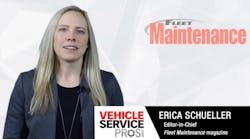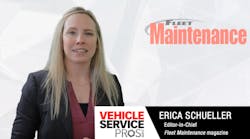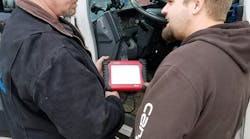Bill Hanvey, president and CEO of Auto Care Association and HDDA, provides a background and status update on the Heavy Duty Memorandum of Understanding (MOU). The Heavy Duty MOU is an aftermarket initiative designed to provide independent repair shops and customers access to the same vehicle repair information as vehicle manufacturers.
Transcription of interview:
Erica Schueller, Fleet Maintenance: Welcome to VSP News: Uptime Update. I am your host Erica Schueller, Editor-in-Chief of Fleet Maintenance magazine, covering all maintenance, all management, all vehicle classes, all the time.
While there are processes fleets have implemented to decrease vehicle downtime, there are still instances where lack of information on how to diagnose or repair a vehicle is still a major issue.
To address this lack of information, industry organizations representing the aftermarket, like the Auto Care Association and HDDA, are working on behalf of independent repair shops and customers to gain access to the same vehicle repair information as vehicle manufacturers.
Previously available only to certified dealerships, or those willing to pay a premium price for the factory scan tool (if and when available), the industry has come to an official agreement on sharing the information with the passing of a state-level Right to Repair Act in Massachusetts, and subsequent nationwide Memorandums of Understanding, or MOUs.
It is important to note there are two separate MOUs – one for the passenger vehicle market, and one for the heavy duty vehicle market.
I sat down with Bill Hanvey, president and CEO of Auto Care Association and HDDA, to discuss the current status of the Heavy Duty MOU in particular.
We first talked about the importance of this initiative to the heavy duty aftermarket.
Bill Hanvey, Auto Care Association and HDDA: The Right to Repair initiative and MOU is critical for the independent aftermarket and fleet maintenance because it ensures that the fleet and the independent heavy duty aftermarket has the same access to vehicle data as the dealership does.
In order for us to preserve the right of independent owner operators and fleets, to have their vehicles maintained at the place they want to have them maintained, we have to ensure that access to that data is shared equally amongst the OEMs, the dealerships and the independent aftermarket.
Schueller, Fleet Maintenance: One example of this already showing up in fleet maintenance facilities is the increased use of heavy duty aftermarket scan tools. These tool manufacturers rely on having access to repair information from OEs in order to provide a functional tool for technicians working on commercial vehicles.
Hanvey explains how the Heavy Duty MOU plays a role in this.
Hanvey, Auto Care Association and HDDA: We’re working very closely in conjunction with ETI, or the Equipment and Tool Institute, to ensure that they are able to access the data. Think of it as, if you’re a fleet, you don’t want to have to buy one tool for a specific make or model. You want to be able to buy a tool and have that software incorporated for all makes and models into that particular tool.
We are working with ETI very closely on this initiative, and on the automotive side as well, to ensure that those tool manufacturers are able to provide all makes, all models, and get the data and engine codes they need from the OEMs.
Schueller, Fleet Maintenance: With that, an official Heavy Duty MOU was signed in August of 2015 by representatives from the Auto Care Association (at the time known as AAIA), the Commercial Vehicle Solutions Network, or CVSN, the Equipment and Tool Institute, Heavy Duty Aftermarket Canada and the Truck and Engine Manufacturers Association, or EMA.
Since that time, steps have been taken but there are still some inconsistencies with information, according to Hanvey. He shares more.
Hanvey, Auto Care Association and HDDA: The current status of the MOU is that we have actually done some truck testing to see what the compliance is from the OEMs in terms of the data that’s being provided.
(Tests have shown) some of the OEMs were good in terms of the data they provided. Some, not so good.
What we’ve done is recapped the availability of that data, we have sent the letter to the Truck & Engine Manufacturers Association (EMA) to let them be aware of the fact that some of the truck manufacturers were not in compliance, and we are working with them to ensure those truck manufacturers become compliant and that they adhere to the agreement of the MOU and the Right to Repair Act that was passed in Massachusetts.
Schueller, Fleet Maintenance: Hanvey talks a bit more about the next steps to ensuring the success of the Heavy Duty MOU.
Hanvey, Auto Care Association and HDDA: We’ve done the testing (to confirm) who is compliant and who is not compliant.
(The next steps for the MOU are that we’re then) really ramping up our education efforts to the industry, to people in Washington and at the state level, to ensure people are aware who is compliant with the MOU, who is not compliant with the MOU, working with OEMs and the Truck Engine Manufacturers Association (EMA) to make people understand that an MOU was signed, and that they have to abide by that MOU.
That is somebody’s word, and we trust people on their word, and we have to ensure its being upheld throughout the heavy duty industry.
Schueller, Fleet Maintenance: If you’d like to read more about Right to Repair and the Heavy Duty Memorandum of Understanding, read a history and overview of this aftermarket initiative by visiting the link below.
Thank you for tuning in to VSP News Uptime Update, I’m your host Erica Schueller.
Until our next broadcast, keep up with this, and other industry topics, by visiting us online at VehicleServicePros.com.
Find out more about Right to Repair and the Heavy Duty MOU.


